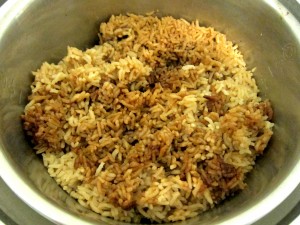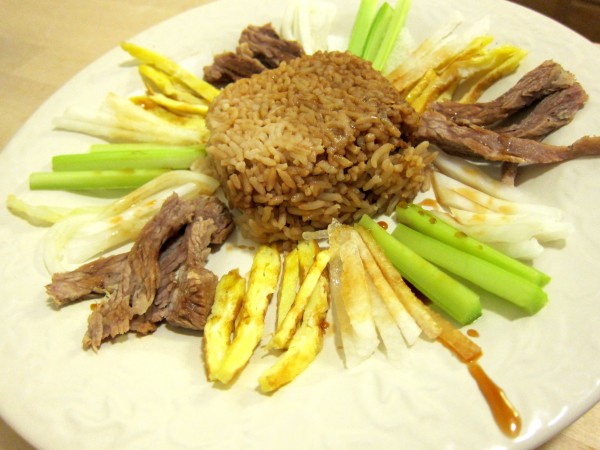
Something occurred to me within the last month: I probably should learn to pair drinks with food, but I hardly drink anything beside water and soymilk. Now I would *love* to learn about the different kinds of water, but living in the city makes it a bit difficult, and soymilk can’t be paired with everything like wine (yet). Coffee, alcoholic beverage, juice? Didn’t quite catch on. So what does that leave me? Tea. A quest takes form: Mai is going to learn tea.
And Mai will cook with tea, too. Because boiling water to drink tea takes some work, I might as well make it worth a meal. How much influence the ochazuke at Mifune had on me, I’m not sure, but during the two minutes of wringling my brain out for some easy way to use tea in food, the first thing that came to mind was cooking rice with tea. Now that’s the difference between my tea rice and the ochazuke: my tea rice is rice cooked with tea, and the ochazuke is rice eaten with tea, like a soup.
As with everything, there’s the easy way and the hard way to make tea rice.
The hard way: use loose leaf tea
– Pros: the tea quality (fragrance, taste, intensity)
– Cons:
—— If make tea first, then use tea instead of water to cook rice: extra step of cooking = time cost
—— If put tea leaves and rice altogether and cook: you’d have to either eat the tea leaves with the rice (the textures don’t match), or pick it out by hand. This obstacle can be remedied with a small mesh bag, though, if I had one.
The easy way: use tea bags. The pros and cons are just the opposite of the hard way.
If you know me, my very under-equipped kitchen, and my minimalist attitude with time, you know what I chose to do: I let the tea bags float in the water and the rice cooker do its job.

Unlike my other whimsical cooking experiments, tea rice is something I’ve actually made more than one time. I feel so matured. After all those times, I’ve learned that:
1. Green tea gives the rice the tea fragrance, and black tea gives it the tea taste, but neither gives enough of both. White tea is out of the question, unless you’re really proud of your tea sensitivity.
2. One tea bag per cup of water is sufficient. (But how many cups of water per cup of rice is a different matter: it depends on the rice.)
3. Tea rice soaks up the moisture more than normal white rice. You know how the lid of the rice cooker usually has a lot of water droplets on its underside when you open the cooker? When you cook with tea, the lid is almost dry.
As per Little Mom’s suggestion, I combined green and black tea into my latest batch. Three cups of rice, four cups of water, 3 black tea bags, 2 green tea bags. It came out healthily browned, smelling herbal, and tasting clean. Tea rice has an enticing bitter hint and a sweet aftertaste, which is likely the rice’s natural sweetness enhanced by the tea’s lasting subtlety.
But tea rice needs companions, too, something savory enough to make it exciting but plain enough to not overpower its flavors. A thought came, and I nearly cried for missing a Halloween post. So, in the spirit of early November, which is late Halloween, I present to you Black Tea Hades Rice (cơm âm phủ trà đen):

Hades Rice belongs to Huế cuisine, featuring julienned meat, omelet, and vegetables. Such delicate texture of the accompaniments make this style best spotlight the tea rice.
Fried egg, fresh celery, Asian pear, white baechu kimchi (dongchimi style), and boiled brisket were what I could whip out from the fridge, but the silk sausage would be nice to have. Drizzle some sweet garlic soy sauce on top, and the rice just sings. 🙂

This is my contribution to Delicious Vietnam of November, hosted by Sandy of Ginger and Scotch. Can’t wait to see what’s on the table at this 19th round. 🙂
*Delicious Vietnam is a monthly blogging event created by Anh of A Food Lover’s Journey and Hong & Kim from Ravenous Couple.



Mai is gonna go nuts learning tea 🙂 But, I wholeheartedly support your learing about beverages and food as combinations. I have found that it completes the experience of dining.
Yep, let’s see how long I’ll last 😀 It’s a bit hard to start though, I wish I could find a tea club or something around here that I could go to regularly.
Very nice post, Mai! It’s so cool to see how much you have experimented with this. Making flavored rice is a great idea! I did a similar experiment with sticky rice once (http://www.rauom.com/2011/04/27/xoi-tra-tea-flavored-sticky-rice/) and plan to revisit at some point but haven’t thought of making tea-flavored rice until now 🙂
Oh, and I recognize that tea cup in the background 😉 Have you finished your tea yet? Let me know when you want to do the next tea excursion.
Thank you, Oanh! Your xoi tra post is really nice too! Sticky rice is rather heavy in the texture, so lightening it with a herbal scent is such a great idea! I just thought your chrysanthemum xoi could go with rose ice cream, maybe? 🙂
Nah I haven’t finished my tea yet, but I’m going back to the shop this Sunday, would you like to come?
I go two bags black tea “Tra Den” on Ha Noi , old quarter which I like it very much , I am not sure if I can find Duden , Australia .
[…] 6) Black Tea Rice (Com âm phu trà den) […]